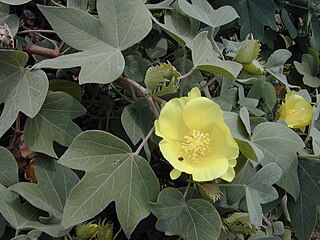
Gossypium is a genus of flowering plants in the tribe Gossypieae of the mallow family, Malvaceae, from which cotton is harvested. It is native to tropical and subtropical regions of the Old and New Worlds. There are about 50 Gossypium species, making it the largest genus in the tribe Gossypieae, and new species continue to be discovered. The name of the genus is derived from the Arabic word goz, which refers to a soft substance.

Gossypium hirsutum, also known as upland cotton or Mexican cotton, is the most widely planted species of cotton in the world. Globally, about 90% of all cotton production is of cultivars derived from this species. In the United States, the world's largest exporter of cotton, it constitutes approximately 95% of all cotton production. It is native to Mexico, the West Indies, northern South America, Central America and possibly tropical Florida.

Gossypium tomentosum, commonly known as Maʻo or Hawaiian cotton, is a species of cotton plant that is endemic to the Hawaiian Islands. It inhabits low shrublands at elevations from sea level to 120 m (390 ft). Maʻo is a shrub that reaches a height of 1.5–5 ft (0.46–1.52 m) and a diameter of 5–10 ft (1.5–3.0 m). The seed hairs (lint) are short and reddish brown, unsuitable for spinning or twisting into thread.
Meloidogyne acronea, the African cotton root-knot nematode or African cotton root nematode, is a plant pathogenic nematode affecting pigeonpeas. It is also an invasive species. The roots and surrounding souls of cereals, grasses, and Gossypium spp. provide habitat for this organism. M. acronea was confirmed as a potentially problematic pest of cotton, Gossypium hirsutum cv. Makoka, which was proven through pot experiments.

Earias perhuegeli, the rough bollworm, is a moth of the family Nolidae. The species was first described by Jeremy Daniel Holloway in 1977. It is found in the northern two-thirds of Australia and several islands in the South Pacific.

Achyra affinitalis, the cotton web spinner, is a moth of the family Crambidae. It was described by Julius Lederer in 1863 and is found in Australia and New Zealand.
Bucculatrix gossypii is a moth of the family Bucculatricidae. It is found in Queensland, Australia. The species was described in 1926 by Alfred Jefferis Turner.
Acrocercops gossypii is a moth of the family Gracillariidae. It is known from South Africa.
Variovorax boronicumulans is a Gram-negative, catalase- and oxidase-positive, non-spore-forming, rod-shaped, motile bacterium from the genus Variovorax. Colonies of V. boronicumulans are yellow in color.
Variovorax defluvii is a Gram-negative, non-spore-forming, motile bacterium from the genus Variovorax, which was isolated from the sewage in the Geumho River in Korea.
Variovorax dokdonensis is a Gram-negative, motile bacterium from the genus Variovorax, which was isolated from soil in Dokdo in Korea. Colonies of V. dokdonensis are yellow in color.
Variovorax ginsengisoli is a Gram-negative, non-spore-forming, rod-shaped, motile bacterium from the genus Variovorax, which was isolated from soil from a ginseng field in Pocheon in South Korea. Colonies of V. ginsengisoli are yellowish in color.
Novosphingobium gossypii is a Gram-negative, rod-shaped and non-spore-forming bacterium from the genus Novosphingobium which has been isolated from tissues from the plant Gossypium hirsutum.
Mucilaginibacter is a genus from the family of Sphingobacteriaceae.
Mucilaginibacter gossypii is a Gram-negative, non-motile and plant-growth-promoting bacterium from the genus of Mucilaginibacter which has been isolated from rhizosphere soil from cotton plants.
Mucilaginibacter gossypiicola is a Gram-negative, non-motile and plant-growth-promoting bacterium from the genus of Mucilaginibacter which has been isolated from rhizosphere soil from cotton plants.
Variovorax humicola is a Gram-negative, non-spore-forming, rod-shaped and motile bacterium from the genus of Variovorax which has been isolated from forest soil near the Kyonggi University from Suwon in Korea.
Variovorax guangxiensis is an aerobic bacterium from the genus of Variovorax which has been isolated from rhizosphere soil of a banana tree from Guangxi in China. Variovorax guangxiensis produces 1-aminocyclopropane-1-carboxylate deaminase.
Saccharibacillus endophyticus is a Gram-positive, facultatively anaerobic and endospore-forming bacteria from the genus of Saccharibacillus which has been isolated from the plant Gossypium hirsutum.




